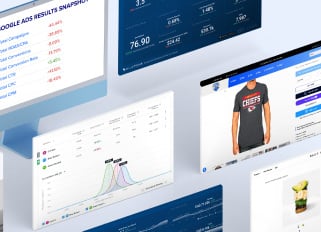The Ultimate Guide to Improve Email Deliverability for E-commerce
Email marketing is one of the most profitable tools for e-commerce, offering a return on investment (ROI) as high as $36 for every $1 spent. However, your success relies heavily on one critical factor—email deliverability.
Simply put…an email campaign cannot generate revenue if it never makes it to your customers’ inboxes.
This comprehensive guide is tailored for e-commerce businesses, email marketers, and online retailers looking to boost their email campaigns. By following these actionable strategies, you can optimize and craft engaging emails, manage your subscriber list effectively, and monitor performance for better results.
Whether you are using tools like Klaviyo, Mailchimp, or HubSpot, these tips will help you ace e-commerce email deliverability while retaining customers through effective campaigns.
Importance of Email Marketing for E-commerce
Despite advancements in paid advertising and other marketing strategies, email marketing remains an essential and highly effective tool for e-commerce businesses. While social media and paid ads often grab the spotlight, email marketing consistently delivers better results. Research shows that email marketing drives more conversions than any other marketing channel.
Here’s why email marketing is crucial for your e-commerce success:
- Targeted Reach: Email campaigns allow you to segment and personalize messages based on customer behavior and preferences, ensuring they reach the right audience. Subscribers are already interested in your brand, making them more receptive than someone randomly exposed to a social media ad.
- Higher Click-Through Rates: Emails outperform other marketing channels in click-through rates because they target people most likely to engage with your content. A subscriber is more likely to click than someone scrolling through social media.
- Cost-effective: Email marketing offers a higher ROI at a much lower cost compared to traditional advertising methods.
- High Engagement: Emails boast better open and click-through rates than social media posts, enabling direct customer communication.
- Increased Revenue: Research shows that 59% of people say marketing emails influence their purchase decisions.
When done right, email marketing is a powerful, cost-efficient way to drive growth and boost engagement for your e-commerce business.
What is Email Deliverability?
Email deliverability refers to the successful delivery of emails to the intended recipient's inbox. It is influenced by various factors such as sender reputation, content quality, and technical aspects like IP address and email authentication. In simple terms, it determines whether or not your email reaches your subscriber's inbox.
According to Return Path - a leading email deliverability service provider, email deliverability has three main components:
- Inbox Placement: Refers to the percentage of emails that reach the intended recipient's inbox and do not get filtered out by spam filters or land in the promotions tab.
- Delivery Rate: Measures the number of emails successfully delivered to the intended recipients' mailbox, regardless of whether they land in the inbox or spam folder.
- Bounce Rate: Indicates how many emails were not delivered due to technical issues like an invalid email address or a full inbox.
Having a clear understanding of these components is crucial for improving your email deliverability and, ultimately, the success of your e-commerce business.
What You Should Know About Email Deliverability
The most compelling email subject lines won’t make a difference if your messages never reach your subscribers’ inboxes. In 2023, a staggering 45.6% of all emails worldwide were flagged as spam. This highlights a critical challenge for businesses: your efforts to launch your ecommerce business and gather customer data could be in vain if your emails fail to connect with your audience.
Email deliverability depends on four key factors:
- Trustworthiness
- Sender reputation
- Authority
- Content
Spam filters assess these elements before allowing emails to enter inboxes. Overlooking even one of these aspects could significantly harm your marketing campaigns, regardless of whether your emails are viewed on desktops, tablets, or mobile devices.
The good news? You have full control over your email content. Even automated emails rely on pre-written copy generated from customer behavior or data. These emails—whether welcome messages, sales notifications, or follow-ups—follow a consistent structure. And it all starts with an engaging subject line.
Common Causes of Poor Deliverability
Why do some emails end up in spam folders? Here are some common issues that could derail your email marketing efforts:
- Lack of proper authentication
- Use of a blocklisted IP address
- Damaged domain reputation
- Recipients flagging your emails as spam
- Unclean contact lists (including inactive email addresses)
- Missing reply-to email addresses
- Use of suspicious open URLs
- Suspicious attachments
- A history of spam complaints
Internet service providers (ISPs) act as gatekeepers between you and your subscribers. While they don’t read the content of your emails (since it’s private), they analyze other metrics like your domain and sender reputation to determine if your messages are trustworthy.
Fortunately, there are solutions to address these issues and optimize your email marketing strategy. By resolving these challenges, you’ll ensure your emails reach your audience, helping you capture new customers’ attention and keep your e-commerce store thriving.
When combined with other strategies, like social media marketing, improving email deliverability can be a game-changer for customer retention and long-term success.
.jpg?width=600&height=400&name=email-notification-woman-hand-on-the-computer-lap-2024-12-07-17-23-26-utc%20(1).jpg) How to Improve Email Deliverability for E-commerce
How to Improve Email Deliverability for E-commerce
Now that we have established the importance of email marketing and what email deliverability entails, let's explore some strategies to boost the success of your e-commerce email and email marketing campaigns.
Part 1: Setting Up Your Email Infrastructure
Your email infrastructure forms the backbone of deliverability. Without proper setup, even the most compelling email content can end up in the spam folder.
Authenticate Your Email with SPF, DKIM, and DMARC
Authentication protocols are a must for spam prevention, providing ISPs (Internet Service Providers) with the assurance that you are a trustworthy sender.
- SPF (Sender Policy Framework): This validates that your emails are being sent from authorized servers.
- DKIM (DomainKeys Identified Mail): Adds an encrypted signature to prove your email hasn’t been tampered with.
- DMARC (Domain-based Message Authentication Reporting & Conformance): Provides instructions to ISPs on what to do if your email fails SPF or DKIM authentication.
Setting these up builds your reputation as an email sender, improves email deliverability rates, and ensures safe communication with your audience.
IP Warm-up: Building a Positive Sending Reputation
If you're just starting out or switching to a new email services provider like Klaviyo, Mailchimp, or HubSpot, it's crucial to warm up your IP address. Sending too many emails too soon can trigger spam filters. Here’s what you should do:
- Gradually increase the volume of emails you send over several weeks.
- Focus on engaging your most active subscribers first to show ISPs that your emails are welcome.
A good sending reputation increases the likelihood that your emails will land in inboxes rather than the junk folder.
Choosing the Right Email Service Provider (ESP)
Platforms like Klaviyo, Mailchimp, and HubSpot offer advanced features to enhance deliverability, including built-in tools for tracking, segmentation, and automation. Choose an ESP that aligns with your e-commerce goals and provides robust analytics. Look for features like spam test previews, segmentation tools, and integrations with your store's platform.
Part 2: Crafting Engaging and Deliverable Email Content
Engaging content is critical to retaining your audience and avoiding spam traps. Here's how to create emails that perform.
Optimize Subject Lines to Avoid Spam Filters
Your subject line is the first thing your subscriber sees, so it must grab attention without sounding spammy.
- Avoid excessive punctuation (!!!) and all caps.
- Stay away from trigger words like “Free,” “Urgent,” or “Guaranteed.”
- Keep it concise and compelling, ideally under 50 characters.
For example, instead of “BUY NOW! 50% OFF!!!!” try something like “Save 50% on Your Favorite Coffee Blends Today.”
Personalize Your Email Content for Better Engagement
Personalization connects your audience and boosts engagement, which ISPs monitor as a metric for email quality.
- Use the recipient’s first name in the email or subject line.
- Send product recommendations based on their browsing history or past purchases.
- Tailor emails to important moments, such as birthdays or anniversaries.
Design Mobile-Friendly Emails
Over 50% of emails are opened on mobile devices. To ensure deliverability and readability across all devices, follow these best practices:
- Use a single-column layout for easy scrolling.
- Make CTA (Call-to-Action) buttons prominent and clickable.
- Optimize images to load quickly.
Remember, a slow-loading email message is as bad as one that isn’t deliverable at all.
Part 3: Managing Your Subscriber List
Managing your subscriber list is crucial for maintaining high deliverability and engagement rates. A poorly managed list can harm your email performance and audience trust.
Implement a Double Opt-In Process
Double opt-ins ensure that subscribers genuinely want to receive your emails, reducing spam complaints and improving engagement.
- When users sign up, send a confirmation email asking them to click a link to verify their subscription.
- Use this step to clearly communicate what kind of emails they’ll receive and how often.
Regularly Clean Your Email List
Keeping your email list up to date is essential for better performance. Inactive subscribers can hurt engagement metrics, so it’s important to clean your list regularly.
- Identify users who haven’t opened your emails in the past 90 days.
- Send a re-engagement email inviting them to stay subscribed. If they remain inactive, remove them from your list.
 Provide a Visible Unsubscribe Link
Provide a Visible Unsubscribe Link
An easy-to-find unsubscribe option is critical for maintaining trust and compliance with email laws.
- Always include a clearly visible unsubscribe link in every email you send.
- Make the process simple and hassle-free to avoid frustrating your audience.
Segment Your Audience for Targeted Campaigns
Effective segmentation allows you to send relevant content, improving engagement and reducing spam risks.
- Group your audience by demographics like location or age.
- Use purchase history or browsing behavior to send tailored offers or recommendations.
Mailchimp and similar tools offer intuitive features to help streamline segmentation, even for beginners.
Part 4: Monitoring and Improving Email Performance
Even the best email campaigns need ongoing attention to maintain stellar deliverability.
Track Key Metrics
Monitor these key metrics to evaluate your email performance and ensure consistent deliverability:
- Open Rate: Measures how many recipients opened your email.
- Click-Through Rate (CTR): Indicates how many people clicked on links in your email.
- Bounce Rate: Tracks emails that failed to deliver to recipients. A high bounce rate can harm your reputation.
Analyze and Adjust Your Strategy Based on Data
Use analytics tools offered by your ESP to identify what’s working and what needs improvement.
For example:
- If your open rates are low, revisit your subject lines.
- If CTR is lacking, refine your email content or adjust your CTAs.
Use Feedback Loops to Stay Informed
Feedback loops (provided by ISPs like Gmail and Yahoo) notify you whenever your emails are marked as spam. Use this data to understand what triggered the complaint and prevent it from happening again.
Boosting Email Deliverability Is a Long-term Investment
Email deliverability isn’t just about reaching inboxes—it’s about connecting with your audience, building trust, and driving meaningful engagement. By focusing on proper infrastructure, creating engaging content, managing subscribers effectively, and leveraging analytical insights, you can significantly and sustainably improve your email deliverability.
For e-commerce businesses, email deliverability is a cornerstone of an effective ecommerce retention strategy. A strong sender reputation not only increases engagement but also drives conversions, helping you retain loyal customers and fuel business growth.
Looking to elevate your ecommerce retention strategy? The experts at Bluetuskr, a leading ecommerce marketing agency, are here to help you maximize the impact of your email campaigns and achieve lasting results. Contact us today!
Connect With Us
Recent Post

.png)





Tell us what you think!